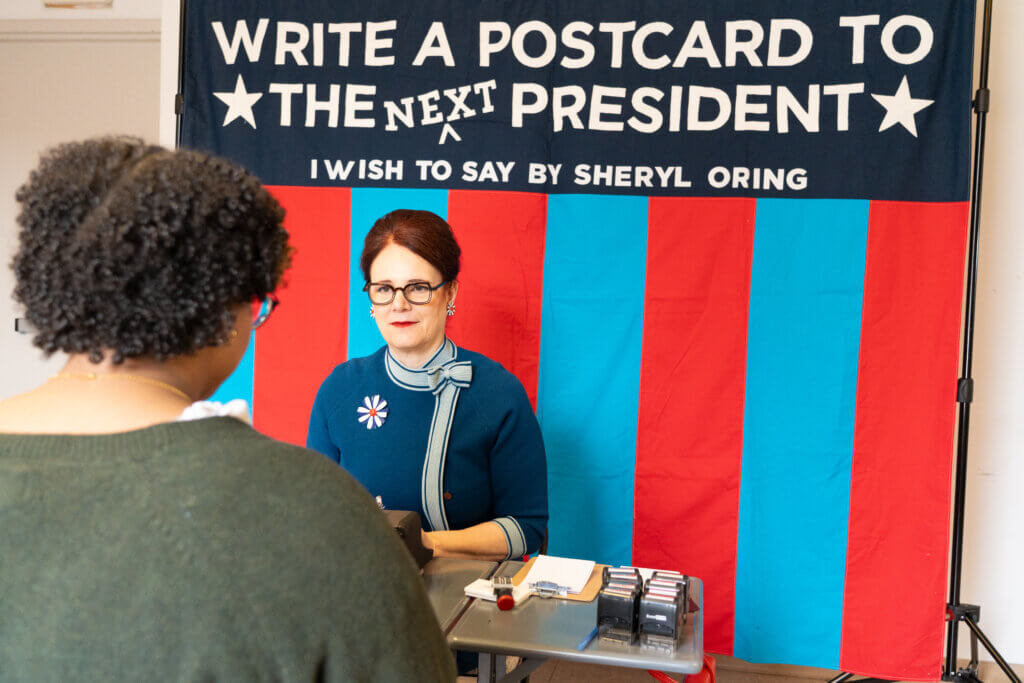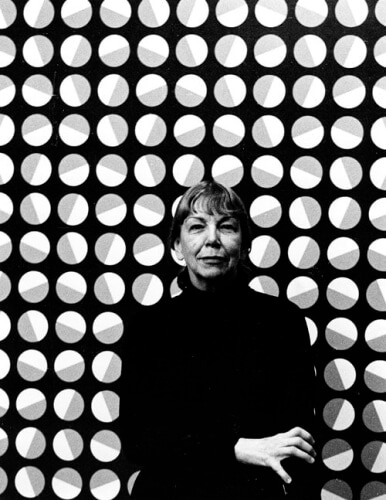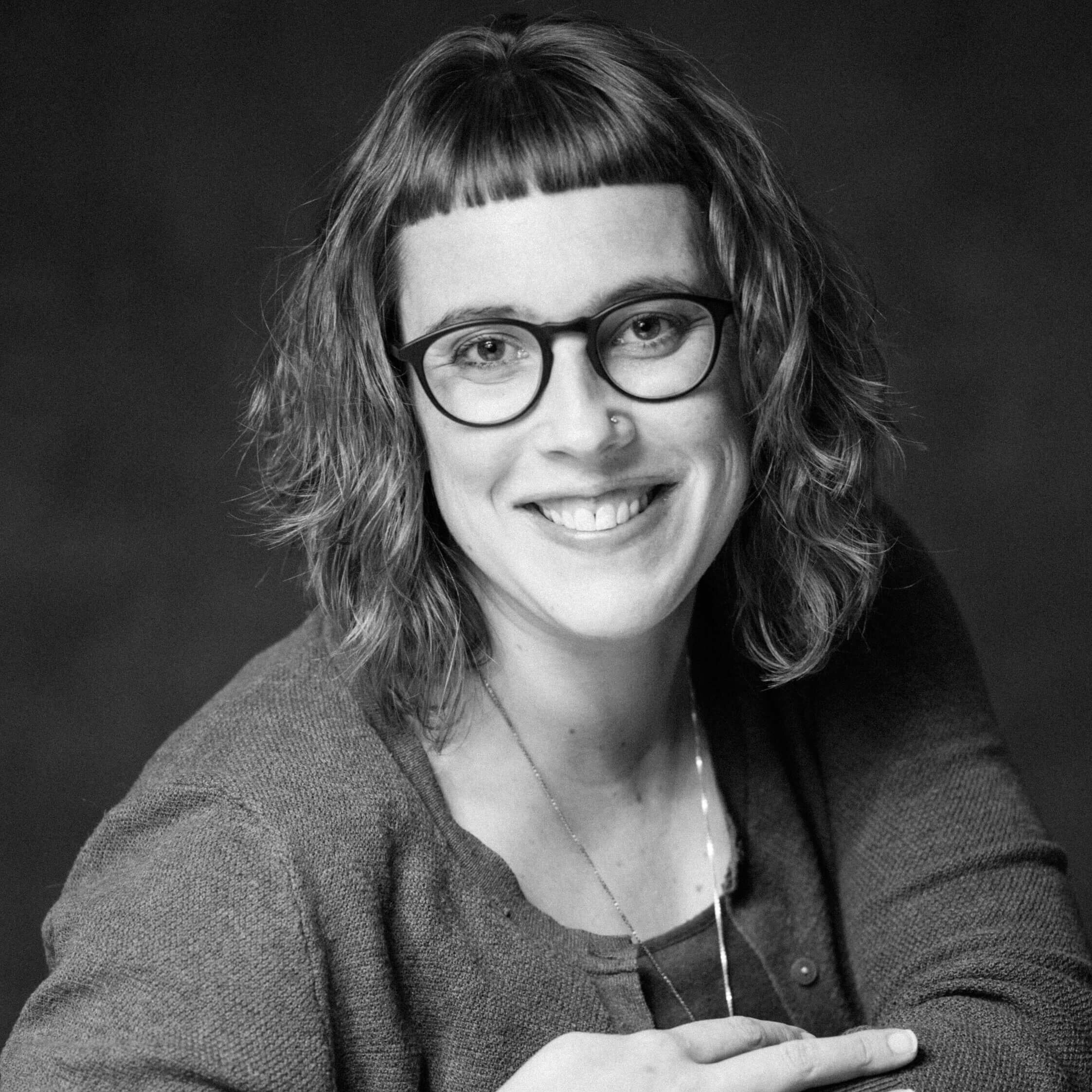Corey Dzenko, Ph.D., associate professor of art history in the Department of Art and Design, has been awarded the Edna Wright Andrade Grant from the Philadelphia Foundation in support of the fall 2024 exhibition she is curating of Sheryl Oring’s social practice art. The exhibition, “I Wish That I Had Spoken Only of It All,” showcases the 20th anniversary of Oring’s project, “I Wish to Say,” and related pieces.
With backgrounds in journalism and fine art, Oring began her ongoing project “I Wish to Say” in 2004 from a concern that many people’s voices were not being heard. She started to take dictation from the public about what they wanted to say to the (next) president. Dressed as a 1960s secretary with a typewriter, she records whatever participants say onto a postcard, making copies with carbon paper. During larger events, a secretarial bank takes dictation. Oring mails the postcards to the White House and exhibits copies. To date she has mailed over 4,100 postcards.

A bank of typists collect postcards to the president during the CarolinaFest in Charlotte, North Carolina. Sept. 3, 2012. Photograph by Dhanraj Emanuel.
From Sept. 3 to Dec. 20, 2024, Monmouth University’s DiMattio Gallery will chronologically display hundreds of “I Wish to Say” postcards, photographs, and videos of performances, along with larger prints of select postcard texts. A timeline on the wall will note the presidential elections that span Oring’s project. The empty wall space for 2024 will fill as Monmouth Unviversity student-typists add postcards they collect during the current election season. The other half of the gallery will showcase a selection of Oring’s related projects that all involve a question, active listening, and a typewriter for a secretary to record dictation. These include “Collective Memory” (September 2011), recorded memories of the 9-11 attacks; “Travel Desk” (2014), travel stories that were then carved into a wooden table now installed in the San Diego International Airport; and other artworks.
Multi-part programming will include an artist’s talk to showcase Oring’s timely and inclusive artmaking practice. Monmouth students will participate as typists at numerous live events throughout the exhibition’s duration. faculty from various disciplines will hold public teach-ins in the gallery about topics related to Oring’s project. Finally, Monmouth University is collaborating with nearby Neptune and Long Branch school districts so that high school students can dictate their own postcards to the future president. As an educator, Oring has increasingly involved younger constituencies, empowering the next generation of participants in both U.S. democracy and artmaking.
Dzenko has typed as part of Oring’s “I Wish to Say” at least half a dozen times, first in 2012 as part of the Democratic National Convention’s CarolinaFest. As part of her research, she has published and presented about Oring’s artwork and coordinated Oring’s 2016 visit to Monmouth University as part of the ArtNOW visiting artists series. Dzenko proposed bringing Oring’s exhibition to Monmouth to celebrate its 20th anniversary with the campus and nearby community during the 2024 election season. All events related to this exhibition will be free and open to the public.

Sheryl Oring types at the University of the Arts, Philadelphia. Feb. 8, 2024. Photograph courtesy of the University of the Arts.
Artist Bio—Sheryl Oring
Sheryl Oring examines critical social issues through projects that incorporate old and new media to tell stories, examine public opinion, and foster open exchange. Using tools typically employed by journalists (the camera, the typewriter, the pen, the interview, and the archive), she builds on her experience in her former profession to create installations, performances, artist books, and internet-based works that address themes of citizenship, free expression, first amendment rights, story-telling, and activism through art. Oring received her MFA from the University of California at San Diego. She is currently a board member for the National Coalition Against Censorship. She has held several academic positions, most recently serving as the dean of the School of Art at University of the Arts in Philadelphia.
Oring has shown her work at the O1SJ Biennial; Bryant Park in Manhattan; the Brooklyn Public Library; and the Jewish Museum Berlin. She has also presented work at Art in Odd Places in New York; the Art Prospect festival in St. Petersburg, Russia; Encuentro in São Paolo, Brazil; and the International Symposium on Electronic Art in Dubai. She has completed public art commissions at the San Diego and Tampa International Airports. Collecting institutions include the Library of Congress; Museum of Modern Art; Tate Britain; Bibliothèque nationale de Luxembourg; and many others.
For more about Sheryl Oring, see: https://www.sheryloring.org/

Edna W. Andrade stands in front of one of her paintings in the 1960s.
Artist Bio—Edna Wright Andrade
The estate of Edna Wright Andrade (1917-2008) established a grant in the artist’s name through the Philadelphia Foundation. After high school, Andrade moved from Virginia to Philadelphia, where she studied at the Barnes Foundation and earned a BFA from the Pennsylvania Academy of Fine Arts (PAFA) and University of Pennsylvania in 1937. During World War II, she went on to use her creative skills to make instructional documents, maps, and charts for the Office of Strategic Services (OSS, now the Central Intelligence Agency). In 1960, she began teaching at the Philadelphia College of Art (more recently the University of the Arts), influenced in both her artmaking and teaching by Bauhaus ideas and abstraction by artists like Paul Klee and Piet Mondrian.
Andrade’s paintings from this time are often associated with the Op Art movement, however she found that label to be limiting. She was interested in larger perception and symbolic meaning of forms, rather than just formal experiments toward optical effects. Often, she worked with grids, in part, as she explained, because her life as a wife and worker meant she had limited time to paint. With a grid, she could work a little at a time, leaving the grid to return to the pattern she had plotted out when her time allowed her to do so again. Her interest in science and the symbolic value of shapes meant she looked to nature for patterns and how such patterns relate to the human mind. She was also interested in gestalt psychology, the archetypal psychology of Carl Jung, color theories by Chevreul and Goethe, and other topics. As she explained in 1974, “I find myself in the ancient tradition of all those anonymous artisans who have painted pottery and tiles, laid mosaic pavings, woven baskets and carpets, embroidered vestments and sewn quilts. Our tradition reaches back through eons of time to that genius who first drew a circle and used its magic.”
For more about Edna Wright Andrade, see:
Locks Gallery, https://www.locksgallery.com/artists/edna-andrade
John Dorfman, “Edna Andrade: The Geometry of Perception,” Art and Antiques Magazine, available at: https://www.artandantiquesmag.com/edna-andrade/

